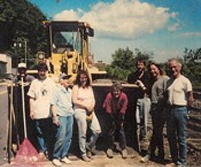We’ve had inquiries about this program from other organizations, towns and states who are thinking about maybe organizing something similar. We hope the previous section, “Apartments-in-Homes Information for Homeowners,” is helpful. But there is other information that may be useful to organizations or government entities.
What it takes to run such a program
Our program is run entirely by volunteers. But it takes quite a lot of work, so in other places it may not work to rely on volunteers.
It takes work partly because there’s a lot of slippage between the initial call from a homeowner and actually getting an apartment built. In our program maybe 10% of calls have produced apartments. The space that’s available turns out to be impractical, the cost is more than the owner imagined, the septic system would need rebuilding, the daughter doesn’t want Mom being a landlord, or the owner just loses interest. Sometimes, before the project dies, we’ve devoted a good deal of time to it.
Projects that get completed have required on average probably 8-10 hours of work by us. It doesn’t take more time because it’s a pretty hands-off process. We don’t do financing. And we take no responsibility for the work. We’re not the general contractor, nor clerk-of-the-works.
Our process
If a project sounds plausible on initial inquiry, our first step is a home visit. The purpose there is partly to explain our program. But it’s also to put the fear of God in the owner – to make sure they consider the work and attention that would be needed, the costs not only of construction but of operation, and difficulties that can come with being a landlord.
At the same time we look with them at the space they have in mind. We’re not architects or engineers, but we’ve learned some things to look for. Will there be adequate means of escape? Will the water lines get to the new kitchen without freezing? What about sound deadening? Closet space? If the space is in a basement, will there be enough light, and would they have to pump the wastewater? And always, out of downtown, the septic problem. Life is much simpler with town water and sewer!

LEAD Technologies Inc. V1.01
After each home visit we complete a report so that we don’t forget what we’ve learned and so that another member of our group could pick up on the project. The report describes the project, assesses both the plan and the owner, and records what they and/or we are to do next.
If the owner’s thought the thing through, wants to proceed and has a clear plan in mind, we can bring in a (volunteer) builder experienced with this kind of work to give them a very rough estimate of cost – or not really an estimate but a range.
If the lay-out of the apartment isn’t obvious, we often can enlist as architects the advanced class in the regional career center’s Architectural Drafting and Design program.
Owners then usually need to find financing. Costs have ranged from $8,000 to $45,000. We provide only $3,000, and that is not until the job is done.
Meanwhile, hopefully, the owner’s lined up a contractor and gotten any permits that are needed. So then work starts. And when it’s done we check it out and deliver a check.
Affordability
We have no affordability requirement. That’s partly because, as a volunteer organization, we’re reluctant to take on the work of monitoring rents. And it is work. By the time you’ve dealt with different utility charges, different fuels and fuel costs, and annual adjustments of everything, it becomes a major project. But also, rent monitoring hasn’t seemed necessary. Affordability is assured by the modesty of the apartments. (There’s some need in Brattleboro for high-end apartments. But they can be built profitably without us, so we don’t help make those.) The highest rent for apartments we’ve helped is about $750 including utilities.
Things we’ve learned
- We’ve learned that this effort would not have got off the ground if an apartment in an owner-occupied house weren’t exempt from fair housing law. It’s one of the first questions people ask: is someone going to tell me who to rent to?
- We thought we’d be dealing mainly with empty-nesters. Instead we’ve been dealing mostly with death or divorce – people left alone with too much house and too little money.
- We thought we’d be dealing with big old houses. In fact we’ve dealt with one. Most homes have been quite modest.
- We’ve learned that, if a homeowner is too poor, undertaking to make an apartment is likely to just add to their troubles.
- We’ve learned that doing this is a great deal easier where there’s municipal sewer and water than where there are septic or water-supply problems to deal with.
- We’ve learned that this is a good way to create new housing:
- It’s cheap – both the cost of the housing and the cost of running the program, whether with volunteers or paid staff.
- It’s energy-efficient. Added fuel and electric use is incremental: it was to a large extent occurring already.
- It’s land-efficient. It uses no new land, creates no sprawl, and increases density while barely changing the character of a neighborhood.
- We’ve learned that we should persuade developers to build accessory apartments into new homes (or at least design homes to facilitate making apartments later).
Can we help?
We are eager to help other places develop ‘apartments-in-homes’ programs. That is why we’ve included a lot of information and materials about our program on this website.
We would be happy to meet with organizations or community groups in our area of New England, or to talk by phone (802 257-4691 or 802-257-4616) or e-mail (info@baahvermont.org).
And we are eager to hear from you your reactions, experience, criticisms or suggestions!


